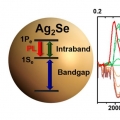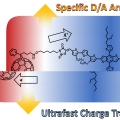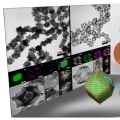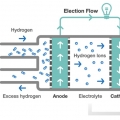| 첨부 '1' |
|---|
| author | Suk Joong Lee |
|---|---|
| journal | Chem. Eur. J. 2017, 23, 11969 – 11976(DOI: 10.1002/chem.201702750) |
| Homepage | http://inmlab.korea.ac.kr/ |
A new nickel(II) porphyrin complex, [NiII(porp)] (1), has been synthesized and characterized by 1H NMR, 13C NMR and mass spectrometry analysis. This NiII porphyrin complex 1 quantitatively catalyzed the epoxidation reaction of a wide range of olefins with meta-chloroperoxybenzoic acid (m-CPBA) under mild conditions. Reactivity and Hammett studies, H218O-exchange experiments, and the use of PPAA (peroxyphenylacetic acid) as a mechanistic probe suggested that participation of multiple active oxidants NiII−OOC(O)R 2, NiIV-Oxo 3, and NiIII-Oxo 4 within olefin epoxidation reactions by the nickel porphyrin complex is markedly affected by solvent polarity, concentration, and type of substrate. In aprotic solvent systems, such as toluene, CH2Cl2, and CH3CN, multiple oxidants, NiII−(O)R 2, NiIV-Oxo 3, and NiIII-Oxo 4, operate simultaneously as the key active intermediates responsible for epoxidation reactions of easy-to-oxidize substrate cyclohexene, whereas NiIV-Oxo 3 and NiIII-Oxo 4 species become the common reactive oxidant for the difficult-to-oxidize substrate 1-octene. In a protic solvent system, a mixture of CH3CN and H2O (95:5), the NiII−OOC(O)R 2 undergoes heterolytic or homolytic O−O bond cleavage to afford NiIV-Oxo 3and NiIII-Oxo 4 species by general acid catalysis prior to direct interaction between 2 and olefin, regardless of the type of substrate. In this case, only NiIV-Oxo 3 and NiIII-Oxo 4 species were the common reactive oxidant responsible for olefin epoxidation reactions.

-
Read More

Mid-Infrared Intraband Transition of Metal Excess Colloidal Ag2Se Nanocrystals
Mihyeon Park(석사과정) Dongsun Choi(박사과정) Steady-state intraband transition, which is a promising electronic transition of a colloidal quantum dot along with the band-gap transition, had been a long-standing challenge. The steady-state ... -
Read More

Enhanced Electron Transfer Mediated by Conjugated Polyelectrolyte and Its Application to Washing-Free DNA Detection
Ji-Eun Jeong (박사과정) Direct electron transfer between a redox label and an electrode requires a very short working distance (<1-2 nm), and in general an affinity biosensor based on the direct electron transfer requires a finely smoothed ... -
Read More

Vertex-reinforced PtCuCo ternary nanoframes as efficient and stable electrocatalysts for the oxygen reduction reaction and the methanol oxidation reaction
Taehyun Kwon(박사과정) / Minki Jun (박사과정) Noble metal binary alloy nanoframes have emerged as a new class of fuel cell electrocatalysts because of their intrinsic high catalytic surface area and accompanied high catalytic activity. Howe... -
Read More

Molecular Role of Ca2+ and Hard Divalent Metal Cations on Accelerated Fibrillation and Interfibrillar Aggregation of α-Synuclein
Jong Yoon Han(박사과정) / Tae Su Choi(Post doc.) α-Synuclein (αSyn) is an intrinsically disordered protein, the aggregation of which is highly related to the pathology of diverse α-synucleinopathies. Various hard divalent metal cations have... -
Read More

Supramolecular Modulation of Structural Polymorphism in Pathogenic α-Synuclein Fibrils Using Cu(II) Coordination
Tae Su Choi(Post doc.) / Jong Yoon Han(박사과정) Structural variation of α-synuclein (αSyn) fibrils has been linked to the diverse etiologies of synucleinopathies. However, little is known about what specific mechanism provides αSyn fibrils... -
Read More

Recent Progress in the Chemistry of Pyridazinones for Functional Group Transformations
Seohyun Kang(석사과정) While N-hetereocycles have received significant attention in organic synthesis and other research fields, the chemistry of pyridazine, six-membered aromatic ring with adjacent two nitrogen atoms, and its derivatives ... -
Read More

Maskless Arbitrary Writing of Molecular Tunnel Junctions
Seo Eun Byeon(석사과정) / Miso Kim(석사과정) Since fabricating geometrically well-defined, noninvasive, and compliant electrical contacts over molecular monolayers is difficult, creating molecular-scale electronic devices that function in h... -
Read More

Single Component Organic Solar Cells Based on Oligothiophene-Fullerene Conjugate
Thanh Luan Nguyen(Post doc.) A new donor (D)–acceptor (A) conjugate, benzodithiophene-rhodanine–[6,6]-phenyl-C61 butyric acid methyl ester (BDTRh–PCBM) comprising three covalently linked blocks, one of p-type oligothiophene containing BDTRh... -
Read More

Lanthanide metal-assisted synthesis of rhombic dodecahedral MNi (M=Ir and Pt) nanoframes toward efficient oxygen evolution catalysis
Haneul Jin(박사과정) / Yongju Hong(박사과정) Mixed metal alloy nanoframeworks have shown a great promise as electrocatalysts in water electrolyzers and fuel cells. Although a limited number of mixed metal alloy nanoframeworks have been synt... -
Read More

Radially Phase Segregated PtCu@PtCuNi Dendrite@Frame Nanocatalyst for the Oxygen Reduction Reaction
Hyukbu Kwon(석사과정) / Jongsik Park(박사과정) Pt-based alloy nanoframes have shown a great potential as electrocatalysts toward oxygen reduction reaction (ORR) in fuel cells. However, the intrinsically infirm nanoframes could be severely d... -
Read More

Collision Cross Sections and Ion Structures: Development of a General Calculation Method via High-quality Ion Mobility Measurements and Theoretical Modeling
Ion mobility mass spectrometry (IM-MS) has become an important tool for the structural investigation of ions in the gas phase. Accurate theoretical evaluation of ion collision cross sections (CCSs) is essential for the effective application... -
Read More

Total Syntheses of Arcyriaflavin A and Calothrixin B Using 2,2′-Bisindole-3-acetic Acid Derivative as a Common Intermediate
Sungjong Lee(석사과정) / Kyung-Hee Kim(박사과정) A new protocol for the synthesis of 2,2′-bisindole-3-acetic acid derivatives from aldimines derived from 2-aminocinnamic acid derivatives and indole-2-carboxaldehyde was developed via a cyani... -
Read More

Synthesis, Characterization, and Efficient Catalytic Activities of a Nickel(II) Porphyrin: Remarkable Solvent and Substrate Effects on Participation of Multiple Active Oxidants
A new nickel(II) porphyrin complex, [NiII(porp)] (1), has been synthesized and characterized by 1H NMR, 13C NMR and mass spectrometry analysis. This NiII porphyrin complex 1 quantitatively catalyzed the epoxidation reaction of a wide range o... -
Read More

Molecular Insights into Human Serum Albumin as a Receptor of Amyloid-β in the Extracellular Region
Tae Su Choi(Post doc.) Regulation of amyloid-β (Aβ) aggregation by metal ions and proteins is essential for understanding the pathology of Alzheimer’s disease (AD). Human serum albumin (HSA), a regulator of metal and protein transportation,... -
Read More

Two Regioisomeric π-Conjugated Small Molecules: Synthesis, Photophysical, Packing and Optoelectronic Properties
Two Regioisomeric π-Conjugated Small Molecules: Synthesis, Photophysical, Packing and Optoelectronic Properties Dae Hee Lee(박사과정) / Thanh Luan Nguyen(Post doc.) Two regioisomeric D1-A-D-A-D1 type π-conjugated molecules (1,4-bis{5-[4-(5-f... -
Read More

Major Electronic Transition Shift from Bandgap to Localized Surface Plasmon Resonance in CdxHg1-xSe Alloy Nanocrystals
Dongsun Choi(박사과정) / Bitna Yonn(석사과정) CdxHg1-xSe alloy nanocrystals are obtained from CdSe semiconductor nanocrystals via cation exchange. By varying the composition during the exchange process, the CdxHg1-xSe alloy nanocrystals off... -
Read More

Rational Design of In Vivo Tau Tangle-Selective Near Infrared Fluorophores: Expanding the BODIPY Universe
The elucidation of the cause of Alzheimer’s disease remains one of the greatest questions in neurodegenerative research. The lack of highly reliable low-cost sensors to study the structural changes in key proteins during the progres-sion of ... -
Read More

Achieving Highly Efficient Nonfullerene Organic Solar Cells with Improved Intermolecular Interaction and Open-Circuit Voltage
A new acceptor–donor–acceptor-structured nonfullerene acceptor ITCC (3,9-bis(4-(1,1-dicyanomethylene)-3-methylene-2-oxo-cyclopenta[b]thiophen)-5,5,11,11-tetrakis(4-hexylphenyl)-dithieno[2,3-d′:2,3-d′]-s-indaceno[1,2-b:5,6-b′]-dithiophene) is... -
Read More

Ionic effect on the excited-state proton transfer reactions in aqueous solutions
Proton dissociation (PD) reactions of weak acids and proton transfer (PT) processes in aqueous solution are strongly influenced by ions. However, a detailed molecular picture that describes how ions affect the rates for PD and PT processes i... -
Read More

A conductive porous organic polymer with superprotonic conductivity of a Nafion-type electrolyte
As potential solid electrolytes in fuel cells, porous organic polymers show compelling proton conductivities (up to ∼10−2 S cm−1), but even higher performance is required for real applications. In this work, we prepared a biphenyl-based orga...


 Total Syntheses of Arcyriaflavin A and Calothrixin B Using 2,...
Total Syntheses of Arcyriaflavin A and Calothrixin B Using 2,...
 Molecular Insights into Human Serum Albumin as a Receptor of ...
Molecular Insights into Human Serum Albumin as a Receptor of ...